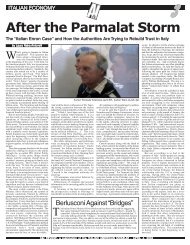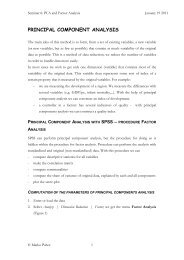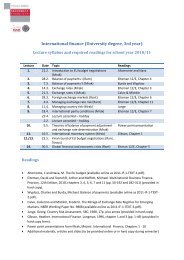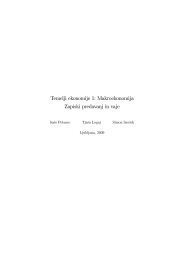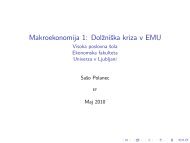OPTIMIZATION OF ONE DIMENSIONAL CUTTING
OPTIMIZATION OF ONE DIMENSIONAL CUTTING
OPTIMIZATION OF ONE DIMENSIONAL CUTTING
Create successful ePaper yourself
Turn your PDF publications into a flip-book with our unique Google optimized e-Paper software.
<strong>ONE</strong>-<strong>DIMENSIONAL</strong> <strong>CUTTING</strong> STOCK <strong>OPTIMIZATION</strong>: THE CASE <strong>OF</strong> A<br />
LOW RATIO BETWEEN STOCK AND ORDER LENGTHS<br />
MIRO GRADIŠAR<br />
Faculty of Economics, University of Ljubljana, 1000 Ljubljana, Kardeljeva ploscad 17,<br />
Slovenia, miro.gradisar@ef.uni-lj.si<br />
The article describes a new method for optimizing one-dimensional stock cutting in the<br />
case of a low ratio between stock and order lengths. The proposed method can resolve the<br />
general cutting stock problem which means that standard stock lengths, non-standard stock<br />
lengths or a combination of both can be cut in exactly the required number of pieces. A<br />
sample problem is presented and solved and a comparison with other methods is made. If<br />
the ratio between the average stock length and the average order length is less than 4,<br />
better results than existing methods can be expected.<br />
Keywords: cutting, optimization, heuristic<br />
Subject classifications: Programming: Integer: Algorithms: Heuristic.<br />
Area of review: Production/scheduling: Cutting stock/trim.<br />
OPTIMIZACIJA ENODIMENZIONALNEGA RAZREZA: PRIMER NIZKEGA<br />
RAZMERJA MED DOLŽINAMI NA ZALOGI IN V NAROČILU<br />
V članku je opisana nova metoda za optimizacijo enodimenzionalnega razreza za primer<br />
nizkega razmerja med dolžino palic na zalogi in dolžino palic v naročilu. Predlagana<br />
metoda rešuje splošni problem razreza, kar pomeni, da omogoča optimizacijo razreza<br />
natančnega števila standardnih ali nestandardnih dolžin oziroma kombinacije obeh.<br />
Metoda je predstavljena na praktičnem primeru, hkrati pa je opravljena primerjava s<br />
podobnimi metodami, ki rešujejo isti problem. Če je razmerje med povprečno dolžino na<br />
zalogi in povprečno dolžino v naročilu manj kot 4, potem je metoda boljša od obstoječih,<br />
kar pomeni, da generira manj neuporabnega ostanka.<br />
Ključne besede: razrez, optimizacija, hevristična metoda<br />
1
1. Introduction<br />
A one-dimensional cutting stock problem (CSP) occurs in different industrial processes.<br />
Many exact or heuristic methods based on an item-oriented (e.g., Gradisar et al. 1997,<br />
Gradisar et al. 1999a), pattern-oriented (e.g., Gau and Washer 1995) or mixed (e.g.,<br />
Gradisar et al. 1999b) approach to solving CSPs have been developed. Exact methods<br />
(e.g., Amor et al. 2006, Cordeau 2006, Alves and de Carvalho 2008) offer optimal<br />
solutions but they can only be used to resolve small to medium-size instances. Also<br />
heuristic solutions can lead to results with a very low unnecessary trim loss which means<br />
that further considerable trim loss reductions are hardly possible. The enhancement of the<br />
method, for example, in (Gradisar and Trkman 2005) leads to a reduction of trim loss from<br />
0.025% to 0.015%. Although the improvement is 60% it represents a very small<br />
contribution to a reduction of company costs.<br />
The trim loss does not only depend on the optimization method but also on the nature of<br />
the problem. In practice, one can find a general one-dimensional CSP (Gradisar et al.<br />
2002) with an average trim loss amounting to 10 or even 20% (e.g., Erjavec et al., 2008).<br />
The reason for that is the very low ratio between stock and order lengths. A considerable<br />
improvement of the optimization method would in such cases also lead to important cost<br />
reductions. However, generally acceptable solutions to this problem have not appeared in<br />
the literature so far. Therefore, the purpose of this article is to propose a new optimization<br />
method for solving a general CSP where the ratio between stock and order lengths is<br />
relatively low.<br />
The rest of the article describes the cutting problem and development of a solution in<br />
the form of a computer program. A sample problem is presented and solved, while a<br />
comparison with other methods is made.<br />
2. Definition of the problem<br />
For every customer order a sufficiently large stock of material is available. Most of the<br />
stock has the same length or there are a few different standard lengths. Some of the stock<br />
can be of several different non-standard lengths as they are leftovers of previous orders and<br />
there is usually just one piece per one non-standard length. We consider the lengths as<br />
integers. If they are not integers then we assume that it is always possible to transform<br />
them into integers. An order consists of a request for a given number of order lengths into<br />
the required number of pieces. The following notation is used:<br />
li order lengths; i = 1,...,m (order lengths are sorted in a decreasing order: l1≥ l2≥ l3 …),<br />
ni the required number of pieces of order length li,<br />
2
Lk stock lengths; k = 1,...,p,<br />
Nk number of pieces in stock of length Lk.<br />
The cutting plan consists of cutting patterns that have been cut from different stock<br />
lengths and of the corresponding frequencies needed to satisfy all orders. Cutting pattern j<br />
that was cut from stock length k may be expressed by a vector<br />
(a1jk , a2jk , a3jk ,..., amjk )<br />
(1)<br />
that satisfies<br />
m<br />
∑ li ⋅ aijk ≤ Lk ,<br />
i=1<br />
(2)<br />
aijk ≥ 0 and integer, (3)<br />
in which aijk represents the number of times order length li appears in this particular<br />
pattern. Let us denote:<br />
xjk frequency of cutting pattern j having been cut from stock length k,<br />
zk total number of cutting patterns (1) cut from stock length k satisfying (2) and (3).<br />
The following integer programming model can be formulated:<br />
p zk<br />
min ∑ ∑ xjk ⋅ Lk<br />
(4)<br />
k=1 j=1<br />
(minimize the sum of stock lengths to be cut)<br />
s.t.<br />
zk<br />
∑ xjk ≤ Nk ∀ k (stock constraints) (5)<br />
j=1<br />
p zk<br />
3
∑ ∑ aijk ⋅ xjk = ni<br />
k=1 j=1<br />
∀ i (demand constraints) (6)<br />
xjk ≥ 0 and integer ∀ j,k. (7)<br />
This description is similar to a general one-dimensional CSP and slightly different to<br />
those of Gau and Washer (1995) because of the multiple stock lengths, stock constraints<br />
and items of order lengths which must be cut into the exactly demanded number of pieces.<br />
Therefore, the described problem cannot be solved using the classic hybrid algorithm<br />
developed by Gilmore and Gomory (1961, 1963).<br />
According to the typology of cutting and packing problems (Dyckhoff 1990, Washer et<br />
al. 2007, Trkman et al. 2007), this problem can be described as pure C&P with input<br />
minimization, heterogeneous large objects and weakly heterogeneous small objects or<br />
1/V/D/M/IN where 1 stands for a one-dimensional problem, V means that all items need to<br />
be produced from a selection of large objects, D means that all large objects can be<br />
different, M indicates many small items of several dimensions and IN stands for<br />
instantaneous.<br />
3. Development of the solution<br />
The proposed sequential heuristic procedure is developed as an iteration of four basic<br />
steps. Each time a proportion of demand is satisfied. The procedure terminates when all of<br />
the demand is fulfilled. At the beginning, all stock lengths belong to the set of unprocessed<br />
stock lengths. The number of unprocessed pieces (UNk) of each stock length Lk equals Nk<br />
while the number of unprocessed pieces (uni) of each order length li equals ni. The set of<br />
processed stock and order lengths is empty. Upon each iteration, the set of unprocessed<br />
pieces of stock lengths is reduced. The number of cut pieces of some order lengths also<br />
changes, as do the processed stock lengths which become equal to the trim loss. When all<br />
pieces of some stock length have been processed in a previous iteration this stock length<br />
cannot be used in the next one. At the end, all uni equals 0. An iteration consists of the<br />
following steps:<br />
Step 1: Solve the knapsack problem and find the optimal and next to optimal solution for<br />
each stock length by only taking unprocessed pieces of order lengths into account.<br />
Step 2: Sort the cutting patterns obtained in step 1 according to a1jk, a2jk, a3jk, ... The result<br />
is a sorted list of patterns. On top of the list are patterns containing longer order lengths,<br />
while the opposite are found on the bottom.<br />
4
Step 3: Starting at the top of the sorted list of patterns and moving sequentially down<br />
select the corresponding frequency for each pattern by taking unprocessed pieces of order<br />
and stock lengths into account. The corresponding frequency is the highest frequency<br />
which at that moment is not higher than the number of unprocessed pieces of<br />
corresponding stock length and at the same time low enough to prevent the overproduction<br />
of any order length. Consequently, immediately after the selection of an individual<br />
frequency reduce the corresponding number of unprocessed pieces of stock and order<br />
lengths.<br />
Step 4: If all the orders are still not fulfilled, then go back to step 1, otherwise stop.<br />
The algorithm is developed on the following assumptions:<br />
1. The optimal or near to optimal solution of the cutting problem in the case of a<br />
lower ratio between the average stock and order lengths consists of the optimal or<br />
next to optimal solution of knapsack problems.<br />
2. It is easier to find a good solution if the cutting patterns containing largest order<br />
lengths are processed earlier.<br />
The first assumption is based on the fact that in the case of a lower ratio between the<br />
average stock and order lengths the number of possible solutions is lower. The probability<br />
that the optimal or next to optimal solution of knapsack problems is also the optimal or<br />
near to optimal solution of the cutting problem is therefore greater.<br />
The second assumption seeks to minimize the influence of ending conditions (Haessler<br />
and Sweeney 1991). It is a statistically proven general fact that it is easier to find a good<br />
solution if it is chosen from the largest possible set of possible solutions (Gradisar et al.<br />
1999a). In order to keep the set of possible solutions as large as possible as long as<br />
possible during the cutting process the longer order lengths are processed earlier. The<br />
algorithm for the optimization of stock length cutting is shown in the flowchart in Figure 1.<br />
Figure 1 Flowchart of the Cutting Algorithm<br />
The flowchart indicates it is necessary to solve a series of knapsack problems in order to<br />
obtain cutting patterns and for each of them to then select the corresponding frequency for<br />
every iteration. The dynamic programming scheme of the KNAPSACK procedure for the<br />
case of four order lengths l1,…, l4 can be summarized as follows:<br />
KNAPSACK procedure:<br />
5
1. initialize Rmin ← Rmin-1← maxint, i← j+1, a1jk←0, a2jk←0, a3jk←0, a4jk←0, a1ik←0,<br />
a2ik←0, a3ik←0, a4ik←0<br />
2. for l = min{un1, int(Lk /l1)} to 0 step -1 do<br />
3. D1 ← Lk - l1⋅ l<br />
4. for m = min{un2, int(D1 /l2)} to 0 step -1 do<br />
5. D2 ← D1 - l2⋅ m<br />
6. for n = min{un3, int(D2 /l3)} to 0 step -1 do<br />
7. D3 ← D2 - l3⋅ n<br />
8. t ← min{un4, int(D3 /l4)}<br />
9. R ← D3 - l4⋅ t<br />
10. if R < Rmin<br />
11. then<br />
12. Rmin-1 ← Rmin<br />
13. Rmin ← R<br />
14. a1ik ← a1jk, a2ik ← a2jk, a3ik ← a3jk, a4ik ← a4jk<br />
15. a1jk ← l, a2jk ← m, a3jk ← n, a4jk ← t<br />
16. endif<br />
17. endfor<br />
18. endfor<br />
19. endfor<br />
In the KNAPSACK procedure a sequence of vectors (1) is generated in a<br />
lexicographically decreasing order to find the optimal and second to optimal pattern for Lk.<br />
The int function converts a numeric expression into an integer; all digits to the right of the<br />
decimal place are ignored.<br />
The time complexity of the proposed algorithm can be calculated similarly as in<br />
(Gradisar et al. 1999a) and mostly depends on m. An acceptable response time can be<br />
expected if m is 7 or less.<br />
6
4. Results<br />
The proposed algorithm is written in the FORTRAN programming language which<br />
enables very rapid processing. The program consists of less than 1,000 lines of code. The<br />
data input and the printout of the results are made in 4GL. The program can be run on a<br />
personal computer. It was called LCUT. LCUT is not intended for general use but for those<br />
cases with a small ratio between stock and order lengths. It can be used as an independent<br />
solution or as ‘add-in’ for existing applications. Because of the complexity of calculations<br />
the time limit for solving each problem is set to 30 seconds. Therefore LCUT needs to<br />
have the following constraints:<br />
- the ratio between the average stock and the average order length ≤ 10<br />
- the number of different order lengths ≤ 7<br />
- the number of pieces for each order length ≤ 99<br />
- the number of different stock lengths ≤ 20<br />
- the number of pieces for each stock length ≤ 99<br />
Creating a cutting plan for a case falling within the listed parameters takes less than 30<br />
seconds on a personal computer (Pentium 4).<br />
As an illustration of the use of LCUT a typical practical case was selected. The data<br />
were supplied by a leading retailer of technical products in South-east Europe. One of its<br />
retail areas is the resale of various metal bars which need to be cut by the retailer to meet<br />
customers’ demands. The input data are shown in Figure 2. The customer order contains<br />
four different order lengths. The sum of the required pieces is 34. There is an abundance of<br />
material in stock: 57 pieces of 15 different lengths. Standard and non-standard stock<br />
lengths are not treated separately. All lengths are in centimeters. The ratio between the<br />
largest stock and the shortest order length is 3.7.<br />
Calculation of the results takes less than 1 second. 29 pieces of stock lengths are used.<br />
All patterns consists of one or a maximum of two pieces. The frequency of the patterns<br />
range from 1 to 11. The total trim loss is 3,345 cm, which makes up 11.98% of the total<br />
utilized stock lengths.<br />
The cutting plan of the presented case was also calculated with three other computer<br />
programs: CUT (Gradisar et al. 1999a), C-CUT (Gradisar and Trkman 2005) and the<br />
LOPT commercial application which is available on the web (bestopt.de). These programs<br />
were selected for comparison because they solve the same type of problem. In all three<br />
cases the results are identical and are presented at the end of Figure 2. The total trim loss is<br />
3,590 cm, which makes up 12.75% of the total utilized stock lengths. The comparison<br />
with LCUT shows that in the case of LCUT the trim loss is 245 cm less, which means a<br />
0.77% saving of total utilized stock lengths.<br />
7
Figure 2 Example of the LCUT, CUT, C-CUT and LOPT Results<br />
To test LCUT more extensively a series of problem instances was generated. To<br />
generate the problem instances a slightly modified problem generator CUTGEN1 (Gau and<br />
Washer 1995, Gradisar et al. 2002) was used. Input data were generated according to<br />
problem descriptors as a random sample of one or more test problems. The problem<br />
descriptors are:<br />
m - number of different order lengths<br />
v1, v2 - lower and upper bounds of order lengths, i.e. v1 ≤ li ≤ v2 ( i = 1,...,n)<br />
n - average demand per order length<br />
P - number of different standard stock lengths<br />
s1, s2 - lower and upper bounds of a standard stock length, i.e. s1 ≤ Lk ≤ s2 ( k = 1,...,P)<br />
N - number of pieces of standard stock lengths<br />
p - number of non-standard stock lengths<br />
u1, u2 - lower and upper bounds of a non-standard stock length, i.e. u1 ≤ Lj ≤ u2 ( j = 1,...,p)<br />
r - number of consecutive generated problem instances<br />
The test problems were generated with the following parameter values:<br />
- determination of order lengths and demands:<br />
By assigning different values to problem parameters m (m = 5, 6, 7), v1 and v2<br />
(v1 = 100 and v2 = 200, v1 = 200 and v2 = 300, v1 = 300 and v2 = 400) and n (n<br />
= 10, 20, 30) and combining them with each another 27 test cases were<br />
generated.<br />
- determination of standard stock lengths:<br />
The number of standard stock lengths P was 10 and the number of pieces N<br />
was 8. This means that the stock consists of 90 pieces, 80 of standard stock<br />
lengths and 10 of non-standard. In this case, it was also possible to solve the<br />
problem with CUT where the highest number of stock lengths is limited to 99.<br />
The lower and upper bounds of standard stock length s1, and s2 were set in such<br />
a way that the ratio between the largest stock and shortest order length for three<br />
pairs v1, v2 was 3, 4 and 5 (s1 = 200 and s2 = 300, s1 = 600 and s2 = 800, s1 =<br />
1200 and s2 = 1500).<br />
- determination of non-standard stock lengths:<br />
The number of non-standard stock lengths p was also 10. The lower and upper<br />
bounds of non-standard stock length u1 and u2 were set similarly as the<br />
standard lengths, except they were 50% shorter (u1 = 100 and u2 = 150, u1 =<br />
300 and u2 = 400, u1 = 600 and u2 = 750).<br />
For each test case 10 consecutive problem instances (r = 10) were generated. In total<br />
there were 270 problem instances. The problem descriptors and seeds used to generate the<br />
8
data for 27 test cases are presented in the first 12 columns of Table 1. All lengths are in<br />
centimeters.<br />
Table 1 The Problem Descriptors and Results for 27 Test Cases<br />
The problem instances were solved with two computer programs LCUT and CUT in<br />
order to compare both algorithms. CUT was selected for a more extensive comparison<br />
because LCUT is meant to be an ‘add-in’ or upgrade of CUT. Although both algorithms<br />
solve a similar problem there is a difference in the calculation of the trim loss between<br />
CUT and LCUT. CUT does not treat all unused parts of stock lengths longer than the<br />
shortest order length as a trim loss. For the purpose of comparison the leftovers of LCUT<br />
were treated in the same way.<br />
The results are shown in the last five columns of Table 1. Each row presents one test<br />
case as the average trim loss in centimeters and in percent calculated from 10 problem<br />
instances for CUT and LCUT. The calculation of each of the 270 problem instances takes<br />
less than 1 second.<br />
From the last column of Table 1 it is evident that in 19 out of 27 test cases CUT offers<br />
better results than LCUT. The difference between the average trim loss of CUT and LCUT<br />
is approximately 10%. The smallest difference is 1% in the case of m is 5 and the greatest<br />
23% in the case of m is 6. If m is 7, then the average difference is 10%.<br />
On the other hand, in all test cases with the lowest ratio between the largest stock and<br />
shortest order length and where n is 10 or 20 the results of LCUT are better. The greatest<br />
reductions of trim loss are seen in test cases 1 and 2. If n is 30 the result of LCUT is only<br />
better in test case 3. This means that the effectiveness of LCUT does not only depend on<br />
the ratio between the stock and order length but also on n. If n is smaller the results of<br />
LCUT are better. In the first three test cases n is 10, 20 and 30 and with a growing n the<br />
reduction of the trim loss decreases: 8.05%, 5.93% and 2.56%. A similar situation is found<br />
for the other test cases. Such dependency between n and the trim loss can be expected<br />
since a growing n increases the number of possible solutions and LCUT is based on the<br />
assumption that this number is low. In general, a low number of possible solutions means a<br />
higher trim loss. In all the test cases where the results of LCUT are better the average trim<br />
loss is relatively high, between 8% and 20%.<br />
9
5. Conclusion<br />
The paper analyzes the problem of reducing the trim loss in one-dimensional stock<br />
cutting where the ratio between the stock and order length is low. The new heuristic<br />
procedure was developed in the form of a computer program called LCUT. Testing LCUT<br />
and comparing it with CUT showed that LCUT provides better results if the ratio between<br />
the average stock and average order length is less than 4, the average number of pieces per<br />
order length is less than 30 and the average trim loss is more than 8%. In most other cases<br />
the results of CUT are better. Therefore, LCUT cannot be used to replace CUT or some<br />
other method but rather as a supplement or ‘add-in’ in the abovementioned cases especially<br />
because the algorithm is relatively fast and in most cases takes less than 1 second to<br />
calculate the cutting plan.<br />
References<br />
Amor H. B., J. Desrosiers, J. M. V. de Carvalho. 2006. Dual-Optimal Inequalities for<br />
Stabilized Column Generation. Oper. Res. 54 454-463.<br />
Alves C. and V. de Carvalho. 2008. A stabilized branch-and-price-and-cut algorithm for<br />
the multiple length cutting stock problem. Comp. Oper. Res. 35 1315-1328.<br />
Cordeau J. F. 2006. A Branch-and-Cut Algorithm for the Dial-a-Ride Problem. Oper. Res.<br />
54 573-586.<br />
Dyckhoff H. 1990. A typology of cutting and packing problems. Eur. J. Oper. Res. 44 145-<br />
159.<br />
Erjavec J., P. Trkman, M. Gradisar. Renovation of the Cutting Stock Process. Internat. J.<br />
Production Res. In press.<br />
Gau T., G. Washer. 1995. CUTGEN1: A problem generator for the Standard Onedimensional<br />
Cutting Stock Problem. Eur. J. Oper. Res. 84 572-579.<br />
Gilmore P. C. and R. E. Gomory. 1961. A linear programming approach to the cutting<br />
stock<br />
problem. Oper. Res. 9 849-859.<br />
Gilmore P. C. and R. E. Gomory. 1963. A linear programming approach to the cutting<br />
stock<br />
problem, Part II. Oper. Res. 11 863-888.<br />
Gradisar M., J. Jesenko, G. Resinovic. 1997. Optimization of roll cutting in clothing<br />
industry.<br />
Comp. Oper. Res. 24 945-953.<br />
10
Gradisar M., G. Resinovic, J. Jesenko, and M. Kljajic. 1999a. A sequential heuristic<br />
procedure for one-dimensional cutting. Eur. J. Oper. Res. 114(3) 557-568.<br />
Gradisar M., M. Kljajic, and G. Resinovic. 1999b. A hybrid approach for optimization of<br />
one-dimensional cutting. Eur. J. Oper. Res. 119(3) 165-174.<br />
Gradisar M., G. Resinovic, and M. Kljajic. 2002. Evaluation of algorithms for onedimensional<br />
cutting. Comp. Oper. Res. 29(9) 1207-1220.<br />
Gradisar M. and P. Trkman. 2005. A combined approach to the solution to the general<br />
one-dimensional cutting stock problem. Comp. Oper. Res. 32 (7) 1793-1807.<br />
Haessler R. W., P. E. Sweeney. 1991. Cutting stock problems and solution procedures.<br />
Eur. J. Oper. Res. 54 141-150.<br />
Trkman, P. and M. Gradisar. 2007. One-dimensional cutting stock optimization in<br />
consecutive time periods. Eur. J. Oper. Res. 179(2) 291-301.<br />
Wascher, G., H. Hausner, and H. Schumann. 2007. An improved typology of cutting and<br />
packing problems. Eur. J. Oper. Res. 183(3) 1109-1130.<br />
11
k← k+1<br />
sort order lengths in decreasing order<br />
12<br />
start<br />
UNk ← Nk, ∀ k; uni ← ni, ∀ i<br />
k←1<br />
procedure KNAPSACK<br />
yes<br />
k < p<br />
sort cutting patterns according to a1jk, a2jk, a3jk, ...<br />
select next pattern<br />
j←<br />
j+2<br />
Figure 1 Flowchart of the Cutting Algorithm<br />
j←1<br />
select first pattern<br />
determine corresponding frequency xjk<br />
UNk← UNk - xjk; uni ← uni - aijk ⋅ xjk , ∀ i<br />
uni = 0, ∀ i<br />
last pattern?<br />
ye<br />
yes<br />
printout the results<br />
stop
DETAILS <strong>OF</strong> ORDER LENGTHS<br />
No. length pieces<br />
1 965 12<br />
2 780 7<br />
3 538 10<br />
4 430 5<br />
DETAILS <strong>OF</strong> STOCK LENGTHS<br />
No. length pieces<br />
1 1200 12<br />
2 750 10<br />
3 685 10<br />
4 590 10<br />
13<br />
5 865 4<br />
6 1600 2<br />
7 600 1<br />
8 500 1<br />
9 1400 1<br />
10 640 1<br />
11 800 1<br />
12 765 1<br />
13 670 1<br />
14 690 1<br />
15 820 1<br />
RESULTS <strong>OF</strong> LCUT<br />
utilized stock lengths<br />
No. length pieces pattern trim loss -%<br />
1 1200 11 1x965[1] 235 19.58<br />
4 590 10 1x538[3] 52 8.81<br />
5 865 2 2x430[4] 5 0.58<br />
5 865 1 1x780[2] 85 9.83<br />
6 1600 2 2x780[2] 40 2.50<br />
9 1400 1 1x965[1]<br />
1x430[4]<br />
5 0.36<br />
11 800 1 1x780[2] 20 2.50<br />
15 820 1 1x780[2]<br />
Total trim loss: 3345 (11.98%)<br />
40 4.88<br />
RESULTS <strong>OF</strong> CUT, C-CUT, LOPT<br />
utilized stock lengths<br />
No. length pieces pattern trim loss -%<br />
1 1200 12 1x965[1] 235 19.58
4 590 9 1x538[3] 52 8.81<br />
5 865 2 2x430[4] 5 0.58<br />
6 1600 2 2x780[2] 40 2.50<br />
8 500 1 1x430[4] 70 14.00<br />
9 1400 1 1x780[2]<br />
1x538[3]<br />
82 5.86<br />
11 800 1 1x780[2] 20 2.50<br />
15 820 1 1x780[2]<br />
Total trim loss: 3590 (12.75%)<br />
40 4.88<br />
Figure 2 Example of the LCUT, CUT, C-CUT, and LOPT Results<br />
14
CUT LCUT<br />
average average<br />
No. m v1 v2 n P s1 s2 p u1 u2 seed trim loss -% trim loss -%<br />
1 2 3 4 5 6 7 8 9 10 11 12 13 14 15 16 13-<br />
15<br />
1 5 100 200 10 10 200 300 10 100 150 111 1865<br />
28.29 1334 20.24 531<br />
2 5 100 200 20 10 200 300 10 100 150 112 3526<br />
25.22 2698 19.29 828<br />
3 5 100 200 30 10 200 300 10 100 150 113 3029<br />
14.23 2484 11.67 545<br />
4 5 200 300 10 10 600 800 10 300 400 121 258<br />
2.23 487 4.13 -229<br />
5 5 200 300 20 10 600 800 10 300 400 122 779<br />
3.28 1041 4.39 -262<br />
6 5 200 300 30 10 600 800 10 300 400 123 1723<br />
4.74 2097 5.77 -374<br />
7 5 300 400 10 10 1200 1500 10 600 750 131 192<br />
1.18 547 3.36 -355<br />
8 5 300 400 20 10 1200 1500 10 600 750 132 569<br />
1.55 708 1.93 -139<br />
9 5 300 400 30 10 1200 1500 10 600 750 133 1186<br />
2.10 1905 3.38 -719<br />
10 6 100 200 10 10 200 300 10 100 150 211 1169<br />
10.25 967 8.47 202<br />
11 6 100 200 20 10 200 300 10 100 150 212 2510<br />
13.71 2219 12.12 291<br />
12 6 100 200 30 10 200 300 10 100 150 213 1706<br />
8.28 2137 10.73 -431<br />
13 6 200 300 10 10 600 800 10 300 400 221 277<br />
1.86 533 3.58 -256<br />
14 6 200 300 20 10 600 800 10 300 400 222 977<br />
3.28 1258 4.22 -281<br />
15 6 200 300 30 10 600 800 10 300 400 223 2280<br />
7.10 2384 7.42 -104<br />
15
16 6 300 400 10 10 1200 1500 10 600 750 231 67<br />
0.31 405 1.92 -338<br />
17 6 300 400 20 10 1200 1500 10 600 750 232 343<br />
0.81 714 1.69 -371<br />
18 6 300 400 30 10 1200 1500 10 600 750 233 645<br />
1.10 1674 2.63<br />
16<br />
-<br />
1029<br />
19 7 100 200 10 10 200 300 10 100 150 311 2806<br />
24.38 2123 18.45 683<br />
20 7 100 200 20 10 200 300 10 100 150 312 3254<br />
14.68 2828 12.76 426<br />
21 7 100 200 30 10 200 300 10 100 150 313 2504<br />
11.28 2636 11.88 -132<br />
22 7 200 300 10 10 600 800 10 300 400 321 638<br />
3.41 784 4.20 -146<br />
23 7 200 300 20 10 600 800 10 300 400 322 2538<br />
7.25 3353 9.58 -815<br />
24 7 200 300 30 10 600 800 10 300 400 323 4915<br />
8.43 4789 8.21 126<br />
25 7 300 400 10 10 1200 1500 10 600 750 331 156<br />
0.64 569 2.33 -413<br />
26 7 300 400 20 10 1200 1500 10 600 750 332 935<br />
1.95 1480 3.09 -545<br />
27 7 300 400 30 10 1200 1500 10 600 750 333 2761<br />
3.24 4071 4.78<br />
sum 43608<br />
48225<br />
Table 1 The Problem Descriptors and Results for 27 Test Cases<br />
-<br />
1310<br />
-<br />
4617




